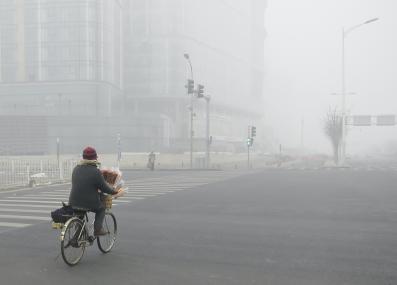Have a question?
How much global warming has been hidden by the cooling effect from sulfur produced by burning coal and oil?
Sulfate aerosols produced when humans burn coal and other fossil fuels have produced a substantial cooling effect, up to nearly 1°C. But global warming far outweighs that effect; so far, human activities have warmed the planet by almost 1.5°C.
January 8, 2025
When we burn coal and oil, these fuels give off carbon dioxide (CO2). Like other greenhouse gases, this CO2 warms the planet, by keeping more of the sun's energy trapped inside our atmosphere.
But coal and oil also produce sulfur dioxide (SO2). Once in the air, SO2 reacts with other molecules to become small particles called sulfates, which have the opposite effect of CO2: cooling the planet. Unlike the greenhouse gases that keep the sun’s energy in the Earth system, sulfates in the atmosphere scatter sunlight back out. These “aerosol” particles can also transform clouds, because they create more surface area for water droplets to attach to. A cloud made up of more particles has denser scaffolding, with smaller water droplets spread between many aerosols. That makes the clouds brighter and whiter, able to reflect more sunlight away from the Earth.
Greenhouse warming and aerosol-related cooling both play a role in human-caused climate change. Taken as a whole, human activities have already warmed the planet by almost 1.5°C,1 but that warming would be even more extreme if not for the influence of our aerosols. Sulfate pollution from power plants and cars—plus a few other human-made aerosols like organic carbon from burning crops and nitrates from our use of fertilizer—have together had a global cooling effect estimated to be somewhere between 0.2°C and 0.9°C.2
“It's a substantial amount, but we don't know exactly how much,” says Jesse Kroll, a professor of civil and environmental engineering and chemical engineering at MIT. “There's a very large uncertainty bar.”
That uncertainty exists in part because researchers don’t have a good handle on how many aerosol particles were in the atmosphere before we started burning massive amounts of fossil fuels. Without knowing this, it’s very hard to estimate how much our aerosols are affecting cloud formation. Are clouds much brighter than they used to be, because they did not previously have many particles to latch onto, or only slightly brighter, because natural aerosols were always abundant? And because aerosols are short-lived and stay close to the places where they’re formed, there are no easy answers to these questions. We can’t find pristine samples of ancient aerosols and trust that they faithfully tell us how abundant these molecules were the world over, the way we can with CO2 locked in prehistoric ice.
At a time when our planet is warming dangerously fast, the cooling power of aerosols may seem like a benefit. But sulfate pollution is extremely hazardous. Particulate pollution is the world’s deadliest environmental hazard, killing millions of people every year.3 “There’s a real need to decrease these emissions,” says Kroll. But, he adds, “there's an unfortunate climate penalty for doing that.”
As we phase out fossil fuels, then, “we could end up unmasking a whole lot of this warming in the future.”
Unfortunately, that doesn’t mean we can keep burning coal and oil and expect sulfates to keep shielding us from their full impacts on our climate. Sulfate aerosols and SO2 last only days or weeks in the atmosphere,4 while CO2 can stay in the atmosphere for hundreds or even thousands of years. And that means that the warming effects of fossil fuels will keep pulling away from their cooling effects as time goes on. As we continue to burn coal and oil, the short-lived sulfates they produce stay fairly constant in the atmosphere, while the long-lived, climate-warming CO2 continues to build up.
So while sulfates are an important ingredient in today’s climate change, they don’t change the fact that the rapid warming of our planet will be less severe the faster we phase out our use of fossil fuels. Still, we should brace ourselves for even more warming while fossil fuels decline, as our past CO2 emissions linger and our sulfate emissions quickly disappear.
“These particles really were just masking climate change,” says Kroll. “They weren't preventing it.”
Thank you to Carl Brenninkmeijer of Bacharach, Germany, for the question.
Submit your own question to Ask MIT Climate
Get the latest from Ask MIT Climate monthly in your inbox
1 Copernicus Programme: Climate Change Service: "Monthly Climate Bulletin: Warmest January on record, 12-month average over 1.5°C above preindustrial." February 2024.
2 Forester, P et. al., "Climate Change 2021: The Physical Science Basis." Figure 7.7. IPCC Sixth Assessment Report, Intergovernmental Panel on Climate Change, 2021. doi:10.1017/9781009157896.009.
3 Health Effects Institute: "State of Global Air Report 2024." 2024.
4 NASA Science Editorial Team: "Aerosols: Small Particles with Big Climate Effects." June 2023.








